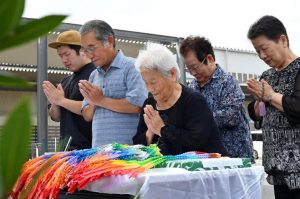Family memories 77 years after A-bombing: Eiko Shintani and son, from Kure City, describe survival day to day
Aug. 7, 2022
Son pledges to convey hardships his mother endured
Asked for water, her own mother fled with water bottle
by Yu Kawakami, Staff Writer
A single atomic bomb destroyed the city area of Hiroshima and altered the lives of a family — a father in the prime of his life and lovely younger sisters. The family members who remained after the bombing struggled to survive in the period after World War II and have passed on their horrific experiences beneath the mushroom cloud to their children and grandchildren, asserting their feelings that such a tragedy must never be repeated. On August 6 this year, they visited places where the memories of that day remain to mourn the dead.
On the morning of August 6, Eiko Shintani, 92, a resident of the area of Ondo-cho in Kure City, Hiroshima Prefecture visited the memorial cenotaph at the Hiroshima headquarters of Kobelco Construction Machinery Co., Ltd., located in Hiroshima City’s Saeki Ward, with her second son, Koji Shintani, 64, and her younger sister. Ms. Shintani placed a photograph of her deceased father, Shuichi Moriichi, at the cenotaph and offered to the monument a string of one-thousand paper cranes. She spent half a year folding the cranes, while recalling the summer scenes she had witnessed 77 years ago.
On August 5, 1945, Ms. Shintani, who was then 15 and lived in the dormitory of a teacher’s school in Mihara City in Hiroshima Prefecture, had returned to her family’s home in Ondo-cho, Kure City, and had lunch there together with her father, Shuichi, her mother, Momoe, and five other siblings. That was the first time in a while that the entire family had the opportunity to sit down to eat.
The next day, August 6, Shuichi was scheduled to work on the dismantling of buildings in the area of Tenjin-machi (now part of Hiroshima’s Naka Ward) for the creation of fire lanes in the war effort, together with his colleagues at Yutani Heavy Industries (now Kobelco Construction Machinery). When Shuichi complained, “I’m sure not looking forward to that work tomorrow,” Momoe admonished him with a smile. “You would be called unpatriotic,” his wife said. In the evening, Ms. Shintani walked with her father to the Kure train station on her way back to her dorm.
Ms. Shintani recalled that moment in a voice tinged with emotion. “I waved to my father through the window of the train. I never imagined it would be my last farewell to him.” Shuichi died in the atomic bombing near the hypocenter. He was 38. His remains have yet to be found.
Starting August 8, two days after the bombing, Momoe took five of her children and entered the central area of Hiroshima in search of her husband, Shuichi. She carried her youngest daughter, who was then one-year-and-10-months old, on her back and walked with four other children, a son and three daughters, around the ruins amid countless corpses lying about. One dying victim stopped her and asked for water, but she continued on carrying a water bottle in her hand. “I’m so sorry, but we also have to live,” Momoe had said.
Until she died at age of 101 in 2012, Momoe had told the story numerous times of her experience at that time. Because Ms. Shintani had been in her dormitory, she was able to avoid exposure to radiation by not entering the city after the atomic bombing. After the war, she supported the family as an elementary school teacher. Her younger brother was given the nickname “Pika-don,” an expression describing the flash (“pika”) and blast (“don”) from the bombing, and bullied. Her younger sister hid the fact that she was an A-bomb survivor until she married.
Koji returned from Kitakyushu City in Fukuoka Prefecture to his parents’ home four years ago following his retirement. To pass on to future generations his family’s A-bombing experience, he applied to undergo training in the Hiroshima City program called “Family A-bomb Legacy Successors,” which was launched earlier this year. He has visited relatives living in different locations within the prefecture and read the personal accounts of numerous A-bomb survivors associated with Yutani Heavy Industries.
Koji hopes to make his debut as a legacy successor in two-years’ time. He made the pledge to do so in front of the cenotaph that he and his family recently visited. “I’ll make sure I convey to schoolchildren where and how my grandfather died and the hardships experienced by my mother and her siblings,” he said.
(Originally published on August 7, 2022)








